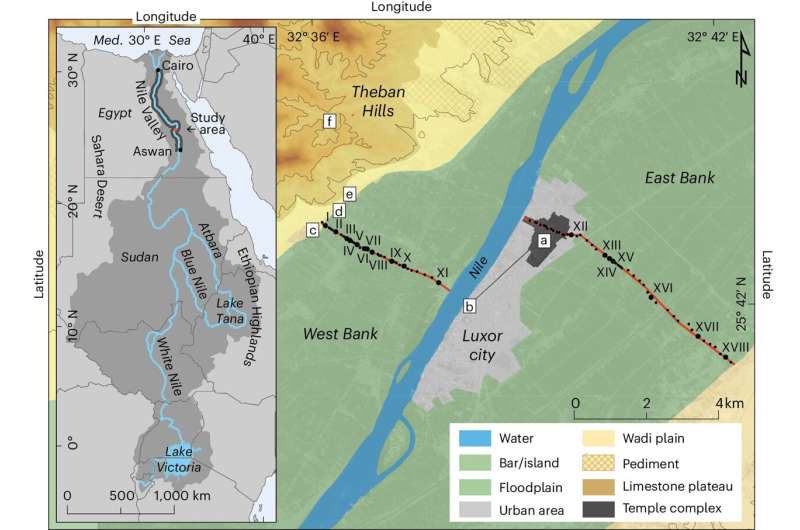This article has been reviewed according to Science X's editorial process and policies. Editors have highlighted the following attributes while ensuring the content's credibility:
fact-checked
peer-reviewed publication
trusted source
proofread
Crucial shift in River Nile's evolution during ancient Egypt discovered

Researchers have explored how the River Nile evolved over the past 11,500 years and how changes in its geography could have helped shape the fortunes of ancient Egyptian civilization.
The research, "Shift away from Nile incision at Luxor ~4,000 years ago impacted ancient Egyptian landscapes" published in Nature Geoscience reveals a major shift in the Nile around four thousand years ago, after which the floodplain in the Nile Valley around Luxor greatly expanded.
The findings raise the possibility that this shift could have contributed to the success of the ancient Egyptian agricultural economy at points between the Old and New Kingdom periods. The New Kingdom was a period of unparalleled prosperity, military conquest, and cultural achievement in Ancient Egyptian history.
Dr. Benjamin Pennington, a co-author on the paper from the University of Southampton said, "The expansion of the floodplain will have greatly enlarged the area of arable land in the Nile Valley near Luxor (ancient Thebes) and improved the fertility of the soil by regularly depositing fertile silts."
"While no specific causal links can be inferred between this shift and any contemporaneous social developments, the changes in the landscape are nonetheless an important factor that need to be considered when discussing the trajectory of Ancient Egyptian culture."
The study also suggests that changes in the Nile's behavior and landscape might have influenced settlement patterns and the location of iconic historical structures, such as Karnak temple.
The research was carried out by an international team led by Dr. Angus Graham of Uppsala University in Sweden and including several archaeologists and geographers from the University of Southampton.
Dominic Barker, another co-author also from the University of Southampton, explained, "We drilled 81 boreholes, many by hand, across the whole Nile Valley near Luxor—a genuine first for Egypt. Using geological information contained within the cores, and dating the sediments using a technique called Optically Stimulated Luminescence we were able to piece together the evolution of the riverine landscape."
The team found that between around 11,500 and four thousand years ago, the Nile experienced significant valley incision, meaning the river cut down into its bed, creating deep channels and a narrower flood plain. This may have led to more pronounced and forceful flooding.
These flood dynamics would have been in place between the Epipaleolithic period (a time of hunter-gatherer societies) and the Old Kingdom (the "age of the pyramids") and perhaps the Middle Kingdom of ancient Egypt.
"The Egyptian Nile we see today looks very different from how it would have been throughout much of the last 11,500 years," says Dr. Pennington. "For most of this time, the Nile was made up of a network of interwoven channels that frequently changed their course."
Around 4,000 years ago, the Nile abruptly shifted and there was rapid floodplain aggradation, where the river began depositing large amounts of sediment, building up the valley floor. This created a more expansive and stable floodplain.
The river also progressively changed character during this time—from a dynamic wandering-braided system to fewer, more stable channels. The single-channel Nile we are familiar with today didn't really establish itself until around two thousand years ago.
The researchers say the major shift in the Nile's behavior was likely caused by a reduction in the volume of water flowing through the river and an increase in fine sediment supply. This was driven by the aridification of the Nile basin, with the "Green Sahara" of the African Humid Period transforming into the present-day hyper-arid Sahara Desert. This shift in regional climate may have further combined with changing human impacts on the land to make the soil more prone to erosion.
The new insights into the evolution of the Egyptian Nile Valley near Luxor provide essential landscape context for archaeologists and Egyptologists to reinterpret ancient sites in the region and re-consider locations of settlements in the Nile Valley.
More information: Jan Peeters et al, Shift away from Nile incision at Luxor ~4,000 years ago impacted ancient Egyptian landscapes, Nature Geoscience (2024). DOI: 10.1038/s41561-024-01451-z
Journal information: Nature Geoscience
Provided by University of Southampton




















